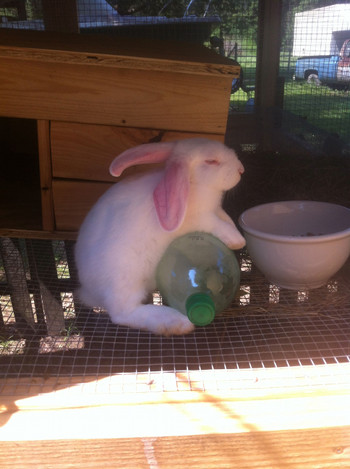
Which breed of rabbit is best for a homesteader?
 When thinking about keeping
meat rabbits, one of the first things that
came up is which breed should we start with?
When thinking about keeping
meat rabbits, one of the first things that
came up is which breed should we start with?
I've had New Zealand Whites and that seems to be a popular breed for
meat. This rabbit variety is also noted for the pelts since they are
pure white. I'm not sure, but I would guess the fur could be dyed,
too, which might make them popular with the buyers of pelts.
We're not really going down this path to sell the pelts, but we also see
that
as a learning opportunity and a potential offset for expenses, or even
as a source of profit. We plan to learn about preserving and/or tanning
the skins as we go as a side project.
Back to breeds. Another popular breed seems to be Californians. We're not
too familiar with these, but are considering crossing a New Zealand
buck with some Californian does. We'll see where we end up.
For now, we've started with New Zealand Whites. We currently have two
bucks and one doe. Not exactly an ideal male to female ratio, but we will
explain in a later post how we ended
up in that situation. There's also more to say about other breeds in a later
post.
Shannon and Dawn will be sharing their experiences with raising meat rabbits on Tuesday afternoons. Shannon and Dawn homestead on three acres in Louisiana when time off from life and working as a sys admin permits.
Want more in-depth information? Browse through our books.
Or explore more posts by date or by subject.
About us: Anna Hess and Mark Hamilton spent over a decade living self-sufficiently in the mountains of Virginia before moving north to start over from scratch in the foothills of Ohio. They've experimented with permaculture, no-till gardening, trailersteading, home-based microbusinesses and much more, writing about their adventures in both blogs and books.
Want to be notified when new comments are posted on this page? Click on the RSS button after you add a comment to subscribe to the comment feed, or simply check the box beside "email replies to me" while writing your comment.

This website has a good table comparing the differant breeds which shows many of them having similer adult weights
http://www.rabbitgeek.com/meatpennotes.html
i cant find my orignal referance that had a graph on dress out %, some breeds were bred for fur others meat some simply for size (NZ) there are are many breeds out there imo that can do better on the homestead or small farm then the commercial breeds, but its all a matter of preferance i suppose
Shannon, see if you can find a local fur buyer in your area and talk to them. They will buy the pelts, if they buy rabbits, "in the green". A green pelt is simply one that has been peeled off the carcass properly, rolled up, placed in a freezer bag and then frozen.
My understanding is that the clothing market likes the white pelts because they can be died to match the garment. Pelts from a rabbit during the summer are worthless, it's only during the colder part of the year where they are worth messing with selling.
I bought my first rabbits from a lady who had crossed the Californian, chinchilla, flemish giant and I believe New Zealand. They look like the silver marten breed (so probably that too) and get 12 to 14 lbs each. She bred them for six years until the breed stabilized.
I haven't eaten one yet to know how they clean up. They are really tolerant to heat and winter cold. If crossing breeds, I heard that you always want to breed a smaller buck to a larger doe to avoid complications at birth.
C Scott Henningsen C --- Good data about the more heirloom breeds. I guess the New Zealands and Californias are a bit like the Cornish Cross of the rabbit world?
Heath --- Excellent data on selling pelts! I didn't realize you had so much firsthand information about it. Maybe you should be writing a guest post.
Dustin --- Hybrids are often very vigorous. I've noticed our Cuckoo Marans X Black Australorp broilers get big faster than the pure breeds.
My theory is to take whatever non-dwarf rabbits you can find for sale in your area as your first meat rabbits.
If they've been bred locally for several generations, then they should be suited to your climate and conditions. If you don't have experience, it's quite likely you'll make some mistakes along the learning curve - better to do that with cheap "meat mutts" than more expensive specialty breeds.
Once you've got some experience, you'll have a much better idea of what you want when you select a breed, and you'll know how to judge a healthy rabbit when buying.